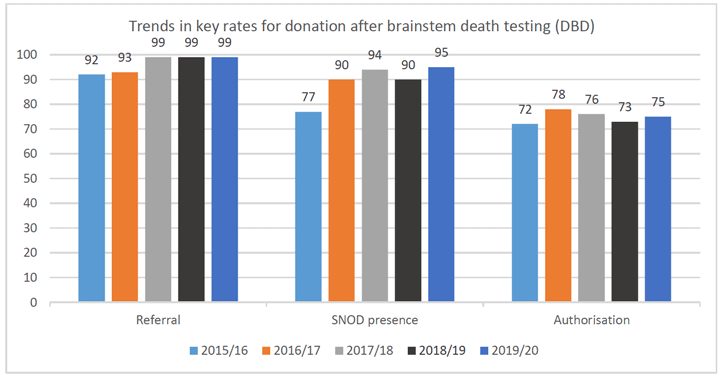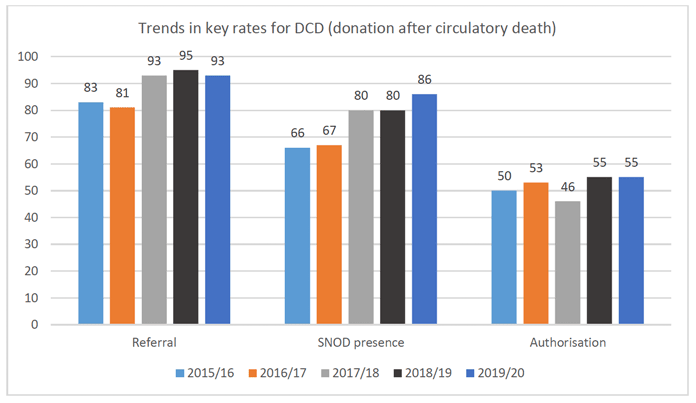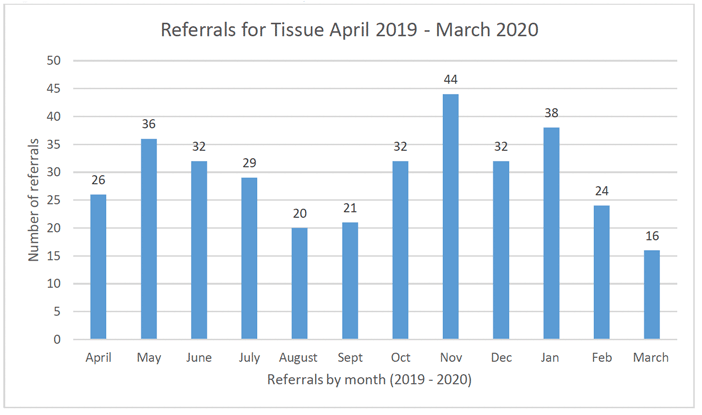Organ and tissue donation: baseline report 2021
Data about organ and tissue donation in Scotland prior to implementation of ‘The Human Tissue (Authorisation) (Scotland) Act 2019’, organised into three main categories: public attitudes, workforce, monitoring data.
Monitoring Data
Evaluation Questions:
8. What is the current authorisation rate for tissue and organ donations?
9. What is the percentage of people becoming donors from the potential donor group?
10. What are the number of transplants occurring (from donors in Scotland)?
11. What kind of support is available for relatives of persons who have authorised, or who have been deemed to have authorised organ and/or tissue donation?
Organ and Tissue Donation Data
Data are recorded by the NHSBT (NHS Blood and Transplant) and SNBTS (Scottish National Blood Transfusion Service) for organ and tissue donation in Scotland. As there are differences between organ donation processes and tissue donation processes and the clinical use of organs and tissue products, these two organisations do not record data about approach of families for an authorisation conversation, successful authorisation, and missed referral opportunities/clinician referrals rates in the same way. Therefore, direct comparison between organ donation and tissue donation cannot be drawn. To allow for useful understandings about trend changes on these aspects during the 5 year M&E period, the data presented in this report will match the format of the originating organisation as closely as possible and separated into data on organ donation and data on tissue donation. assure
Donation authorisation rates are the focus of this Baseline Report, alongside missed referral opportunities/clinician referral rates, family approach rates. Please note that currently, SNBTS does not capture data on the number of families who support a potential donor's donation decision (outcome 9).[13] Donation and transplantation rates will also be reported however it is important to note, as explained in the introduction, that donation and transplantation rates are not the most useful metric by which to measure impact of the Act; this is particularly so in the setting of tissue donation where potential recipients are not on a waiting list. This because there are a large number of contingencies, which are largely clinical in nature, between gaining an authorisation to proceed to donation and successful donation and/or transplantation. Further while donated organs need to be transplanted quickly within a matter of hours, most tissue products donated can be stored for a number of years. Authorisation, referral, and approach rates describe areas of practice which are more likely to be directly impacted by a move to an opt-out authorisation system, the potential increase in the normalisation of donation as a possible end-of-life care choice for patient families, and the normalisation of approaching families about donation as part of end-of-life clinical care practice.
Organ Donation Data
NHSBT publish statistical reports providing a summary of data relating to potential and actual organ donors as recorded by the Potential Donor Audit (PDA), the accompanying Referral Record and the UK Transplant Registry. This Baseline Report presents findings from a number of their reports:
Due to the impact of the COVID-19 pandemic on NHS services and donation activity, all three of these reports cover the time period between 1 April 2019 to 29 February 2020. As such, much of the data presented within this Baseline Report describes activity from this 11 month period within NSHBT's normal reporting period, to counteract impacts of the pandemic on the data. This section focuses on data describing authorisation rates, referral rates, rates of families approached with or without a SNOD, and donation and transplantation rates. It should be noted that this report contains some Scottish specific data that is not routinely published by NHSBT, but was made available to Scottish Government for the purposes of this Report.
Authorisation, Referral, and SNOD presence Rates
It is important to note that NHSBT collects data and reports on activity across all of the UK, and there are slightly different terminologies used, i.e. consent or authorisation. The term authorisation is used to describe the process in Scotland, whereas consent is the terminology used in England. While the processes are not identical in these two geographical contexts they are similar enough to be reported together in NSHBT reports. Reporting will be kept to Scottish data herein however because the label 'consent/authorisation' are used in the published NHSBT reports, the same terminology will be used in this report. It is also important to note that some data are separated into death type, namely DBD (donation after brainstem death testing) or DCD (donation after circulatory death), as these two different death types create different contexts in which the time and way by which a potential donor dies can impact the donation process[14]. For DBD, the potential donor has had a diagnosis of brainstem death and is supported by mechanical ventilation until the controlled removal of ventilation[15]. This is different from DCD, where death follows cardiac arrest.[16]
2019/2020 data:
- The overall consent/authorisation rates (combining DBD and DCD) for Scotland: 64%
- Approaches of a patient family made with SNOD present, in Scotland: 90%
- Referral rate in Scotland: 95%
- 85% of all potential donors had registered a decision on the Organ Donation Register (ODR)
- 26.4% of patients meeting organ donation referral criteria became donors
- 64% of patient families upheld a patient's pro-donation decision and authorised donation
Table 2 describes family approach and authorisation rates in Scotland, Apr 2019 – Feb 2020 in more detail. Whether or not a SNOD was present at the family approach is recorded by NHSBT to measure the effect on the consent/authorisation rates when a SNOD is, or is not, present for the approach to a family for a formal organ donation discussion. NHSBT reported[17] that a patient's family is more likely to support organ donation when a trained SNOD is present for the approach and this is particularly apparent for eligible DCD donors. NHSBT recommends that caution should be applied when interpreting these rates as no account has been taken of approaches initiated by the family, patient's prior opt-in decision or ethnicity.
| Number of eligible DBD donors whose family were approached | DBD consent/ authorisation rate (%) | Number of eligible DCD donors whose family were approached | DCD consent/ authorisation rate (%) | Overall authorisation rate (%) | Overall consent/ authorisation rate (%) for all approaches | |
|---|---|---|---|---|---|---|
| SNOD present for approach | 94 | 79.8% | 95 | 63.2% | 71.4% | 64.6% |
| SNOD not present for approach | 5 | 0.0% | 15 | 0.0% | 0.0% |
Trend data for key aspects of the donation process, delineated by DBD or DCD, can be seen in Figure 5. This data table also shows that the proportion of family approaches with a SNOD present and authorisation rates were all higher in 2019/2020 than they were in 2015/2016, despite slight rises and falls between the 4 year span. This could indicate that these aspects of the donation process have become more normalised parts of clinical practice. Further, as referrals should precede authorisation conversations with family and SNOD presence at authorisation conversations with family, and successful authorisation, rises in the referral rates and conversations with family impact the rate of successful authorisation.
Average referral rates for patients meeting organ donation referral criteria in Scotland from 1 April 2019 - 29 February 2020 were 95%, as there were 386 patients meeting organ donation referral criteria, and 366 of those patients were referred to Organ Donation Service.[19]


NHSBT also tracks family approach and authorisation rates, illustrated in Table 3.
| Activity | DBD | DCD | All |
|---|---|---|---|
| Authorisation rate % | 75% | 55% | 64% |
| Opt-in decision expressed by any method* % | 89% | 85% | 88% |
| Opt-in decision registered on the ODR % | 87% | 82% | 85% |
| No known decision to donate % | 47% | 26% | 34% |
*Any method includes verbal opt-ins and written opt-ins.
NHSBT also tracks referral, family approach, and authorisation rates by ethnicity in Scotland.[23] Table 4 reports this data for the period between 2015 and 2020, due to a small number of eligible BAME donors in some regions. There is a difference in overall authorisation rates between potential donors identified as White compared to those identified as BAME[24]: 62% vs 25%, respectively. This difference persists in the authorisation rates by death type. The data also shows a difference in the approach rate of eligible donor families, suggesting that White eligible donor families are approached at higher rate than BAME eligible donor families, particularly in DBD cases. It is important to note that the difference between referral rates for White and BAME donors is much smaller than that of approach or authorisation rates. Indeed NHSBT reports that for 2019/2020, both DBD and DCD referral rates for BAME potential donors were 100%, compared to 100% and 94% for White donors, respectively. These data help to contextualise the differences by ethnic group for family approach and authorisation rate findings. For example, after a referral of a potential donor to specialist nurses is made, a number of clinical determined reasons can be found which rules out a family approach, leading to low approach rates, particularly in DCD donation.
| Ethnicity | White | BAME |
|---|---|---|
| Number of eligible DBD donors | 496 | 23 |
| DBD donor referral rate (%) | 97% | 92% |
| Number of eligible DBD donors whose family were approached | 457 | 17 |
| Approach rate of DBD donor families | 92.1% | 73.9% |
| DBD authorisation rate (%) | 76.4% | 29.4% |
| Number of eligible DCD donors | 1271 | 24 |
| DCD donor referral rate (%) | 90% | 92% |
| Number of eligible DCD donors whose family were approached | 683 | 11 |
| Approach rate of DCD donor families | 53.7% | 45.8% |
| DCD authorisation rate (%) | 52.4% | 18.2% |
| Overall authorisation rate (%) | 62.0% | 25.0% |
NHSBT collects on reasons recorded for family refusal to give consent/authorisation for organ donation, by ethnicity.[26] These data can give context for differences in overall authorisation rates between potential donors identified as White compared to those identified as BAME. NHSBT report in their discussion of these findings that, '[t]he main reasons BAME families gave for refusing consent/authorisation for organ donation was that they felt it was against their religious/cultural beliefs or they were unsure whether the patient would have agreed to donation. It is important to note that the most fitting reason following family discussion is chosen from a list by the attending/facilitating SNOD. Survey results of BAME communities shows that not knowing enough about organ donation is also a major barrier to organ donation. NHSBT and the National BAME Transplant Alliance (NBTA) have been working in partnership over a number of years to address these barriers. The Community Investment Scheme and the Living Transplant Initiative are now well-established programmes which empower BAME community groups to promote organ donation in targeted groups'.
Donation and Transplantation Rates
Between April 2019 and March 2020, the Scotland Organ Donation Services Team facilitated 109 deceased solid organ donors, resulting in 253 patients receiving a transplant, as illustrated in Table 5.
| Donor Type | Number of donors | Number of patients transplanted |
|---|---|---|
| DBD | 74 | 193 |
| DCD | 35 | 60 |
| DBD and DCD | 109 | 253 |
In terms of percentage of people becoming donors from the potential donors group, 102/386 (26.4%) of patients meeting organ donation referral criteria became donors.
Tissue Donation Data
This section covers available tissue donation data available between April 2019 – March 2020. It is important to note that there are differences between organ donation processes and tissue donation processes and between the clinical use of donated organs versus tissue products. Therefore, direct comparison between tissue and organ donation refusal/authorisation rates is inappropriate. It is also important to note that tissue transplantation may be delayed by several years as the tissue products can be stored in ways that organ products cannot. Further the requirement of matching an organ donor with the organ recipient is not relevant for tissue products where blood group and HLA (Human Leucocyte Antigen) type matching is not required, so that the ethnic group of the donors does not tend to impact the clinical usefulness of the donated tissue products. Data on tissue donation focuses on different aspects of the donation pathway e.g. referral and approach, as it does not need to cover the same breadth of processes, such as death by neurological criteria or withdrawal of life sustaining treatment.
Tissue Referrals
Between April 2019 – March 2020, TDCs received 350 tissue referrals with a mean of 29 referrals per months, as illustrated in Figure 7.

Family Approach Rates for Tissue Donation
There are distinct operational differences between approaches of family members of potential donors for organ donation (such donors may also donate tissue) and tissue only donors. Organ donors often die in an Intensive Care Unit and therefore approaches are routinely made by resident SNODs or ICU consultants. In contrast, tissue donation does not require the potential donor to have died in an Intensive Care Unit so referral of potential donors may come from anywhere in the hospital setting or even from hospices. In view of this, the family members of most people who die and are approached for tissue-only donation are normally informally approached by the doctors or nurses and asked about the donation views of the deceased patient, and whether someone from SNBTS can call them with more information about tissue donation. It is at this point that some families refuse prior to any formal conversation with the Tissue Donor Coordinators (TDC). Any families agreeing to be contacted by SNBTS TDC staff rarely decline the option of donation. It is also important to note that patients being considered for tissue donation may be referred for the potential of donation a number of hours after death and may already be in the mortuary at the time that the family is contacted. For these reasons, direct comparison with organ donation refusal/authorisation rates is inappropriate.
Of the 436 patients in the potential tissue donor pool[28] between April 2019 - March 2020:
- 35% of nearest relatives were approached by clinical staff who had treated the patient in the Emergency Department.
- 36% of the nearest relatives that were approached declined the option to speak with a TDC to formally consider donation.
- There were 28 cases where the family of a deceased person had been approached but donation could not be progressed – the reasons for non-progressions are variable, including both medical and logistical reasons or procurator fiscal declines.
It should be noted that as potential tissue donor audits are undertaken retrospectively and are based on reviews of medical case or bereavement checklists, this figure may be an underestimation as only cases where there is clear documentation of an approach by the clinical staff are included.
Tissue Donation Rates
Tissue donation rates between April 2019 – March 2020[29] were:
- 20 donors donated tissue products
- From these donors, 64 tissue products were donated, which included heart valves and tendons. 65% of the tissue donors had registered a decision to donate on the ODR.
Organ Donor Register (ODR)
The Organ Donor Register monitors the daily number of donation opt-in registrations and opt-out registrations.
Table 6 shows these annual figures from 2018 and 2019, as well as the monthly figures for January and February of 2018-2020. Full Annual data for 2020 is not included in this report, as reporting is only being included up until February 2020 due to the impact of the COVID-19 pandemic. The annual opt-in numbers for 2018 and 2019 were similar and within 1% of each other, while annual opt-outs increased from 3677 opt-outs in 2018 to 6796 opt-outs in 2019.
| 2018 | 2019 | |
|---|---|---|
| Opt-in | 112193 | 112729 |
| Opt-out | 3677 | 6796 |
Table 7 illustrates opt-in and opt-out registrations for January and February 2018, 2019, and 2020. What can be seen is that opt-in registrations have been relatively stable across 2018 – 2020, though rates dropped from 2019 to 2020. In addition, opt-out registrations increased considerably from 2019 to 2020. This rise in opt-out registrations may have been linked to public communication about the upcoming law change (in preparation for the original Autumn 2020 implementation date), and members of the public who feel strongly about not being considered for donation wishing to register that decision before a deemed authorisation system was implemented.
| 2018 | 2019 | 2020 | ||||
|---|---|---|---|---|---|---|
| Jan 2018 | Feb 2018 | Jan 2019 | Feb 2019 | Jan 2020 | Feb 2020 | |
| Opt-in | 9602 | 8563 | 10583 | 9433 | 9973 | 8104 |
| Opt-out | 135 | 640 | 75 | 142 | 3129 | 1010 |
Contact
Email: socialresearch@gov.scot
There is a problem
Thanks for your feedback